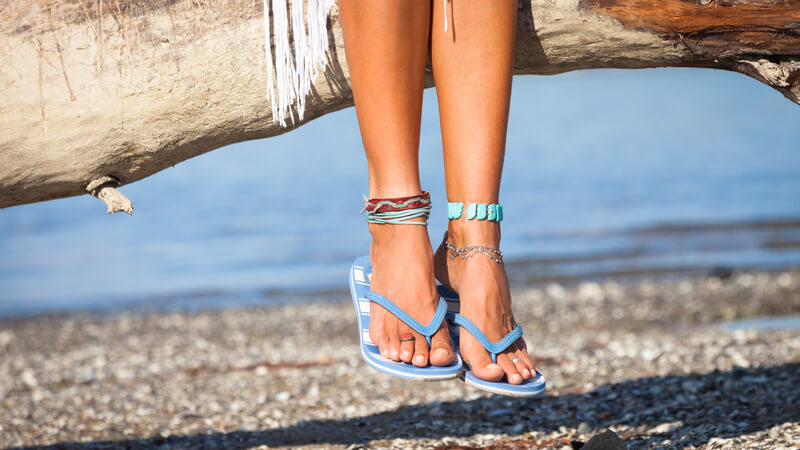Here's how summer shoes may affect your feet, knees, hips and back
 Do you spend the summer in flip-flops, sandals and other casual shoes that are lightweight and breathable but have little support? If so, you may not only be hurting your feet but your joints as well.
Do you spend the summer in flip-flops, sandals and other casual shoes that are lightweight and breathable but have little support? If so, you may not only be hurting your feet but your joints as well.
Summer shoes may be stylish and may keep your feet feeling cool, but since they don't have much heel or arch support, they can change the way you walk and stand. This can lead to foot pain and may also cause issues affecting your knees, hips and back. Additionally, these shoes may exacerbate arthritis.
How can one cute little pair of shoes have such a big impact on your body?
Here's what happens when you walk around in flip-flops or sandals for too long:
- Changes in walking stride – Since flip-flops and other summer shoes don't offer much arch or heel support, it can cause a misalignment in your gait. This means you'll walk differently than you normally would, which strains your joints and ligaments as they compensate for the changes in walking patterns. You may use shorter strides, curl your toes or use other unnatural foot movements as you walk.
- Stronger impact – Since there is no cushioning on most summer shoes, your feet, legs and joints bear the brunt of the impact with each step you take. This can cause pain in your foot, put stress on your ankle, lead to shin splints and increase wear and tear on your joints.
- Poor posture – As your walking stride changes, it may also mess with your body's alignment and posture. This can put pressure on your joints and create muscle imbalances, leading to pain, strain and other joint and muscle-related ailments.
What are some common problems that can be attributed to walking in flip flops or sandals?
Foot pain is the most common malady caused by walking around in flat open shoes. Here are some ways your body may feel the pain of your seasonal shoe choice:
- Plantar fasciitis – This is a painful condition caused by irritation and inflammation of the connective tissues between your feet and toes. The pain is typically felt on the bottom of your foot or inside of your heel.
- Ankle pain – A lack of support puts stress on the ankle. This, as well as an increased risk of tripping, makes it more likely you'll experience ankle sprains and pain.
- Achilles tendon injuries – Changes in how you walk can inflame the Achilles tendon, which connects the heel bone to the calf muscles in the back of your lower leg.
- Shin splints – This condition results in pain along the shinbone in the front of your leg between your knee and ankle and is caused by repetitive stress.
- Knee pain – When you walk differently, it stresses the knees. A lack of cushioning in your shoes to absorb impact also adds increased stress to the joint, which may result in pain or injury.
- Hip pain – Just as with knees, changes to your gait can result in imbalances that lead to hip pain.
- Back pain – Not only does your gait change, but walking in shoes like flip-flops may affect your posture, causing pain and discomfort in your back.
Copyright 2024 © Baldwin Publishing, Inc. Health eCooks® is a registered trademark of Baldwin Publishing, Inc. Cook eKitchen™ is a designated trademark of Baldwin Publishing, Inc. Any duplication or distribution of the information contained herein without the express approval of Baldwin Publishing, Inc. is strictly prohibited.
Date Last Reviewed: June 20, 2024
Editorial Review: Andrea Cohen, Editorial Director, Baldwin Publishing, Inc. Contact Editor
Medical Review: Perry Pitkow, MD
Learn more about Baldwin Publishing Inc. editorial policy, privacy policy, ADA compliance and sponsorship policy.
No information provided by Baldwin Publishing, Inc. in any article is a substitute for medical advice or treatment for any medical condition. Baldwin Publishing, Inc. strongly suggests that you use this information in consultation with your doctor or other health professional. Use or viewing of any Baldwin Publishing, Inc. article signifies your understanding and agreement to the disclaimer and acceptance of these terms of use.
